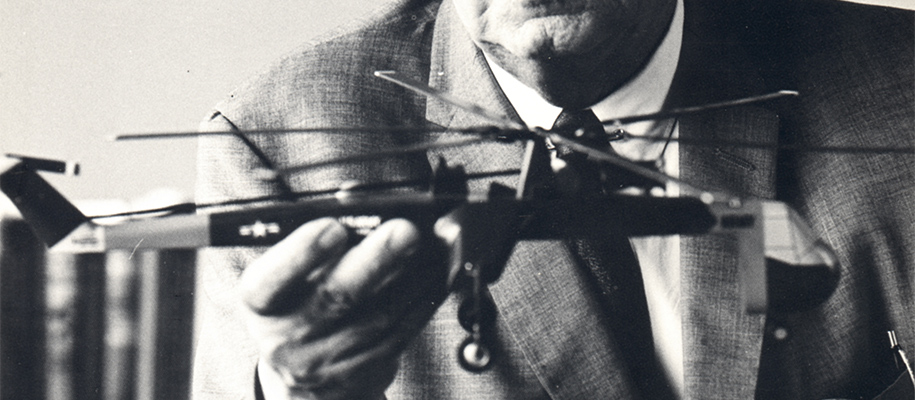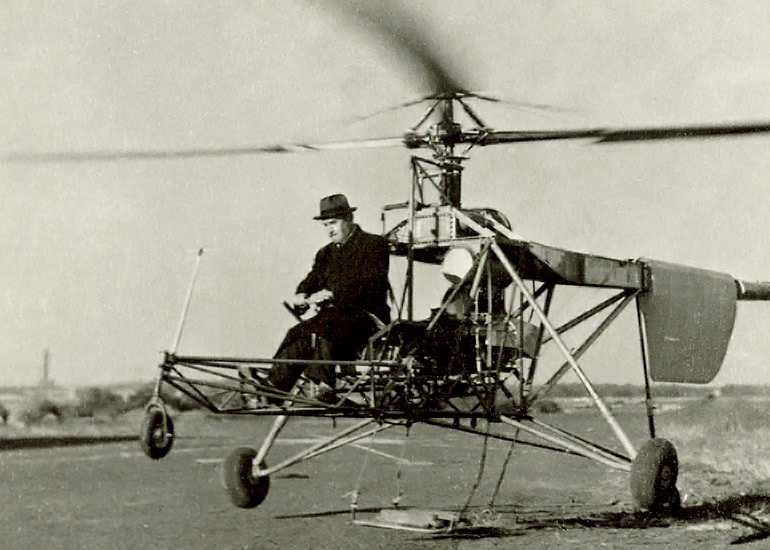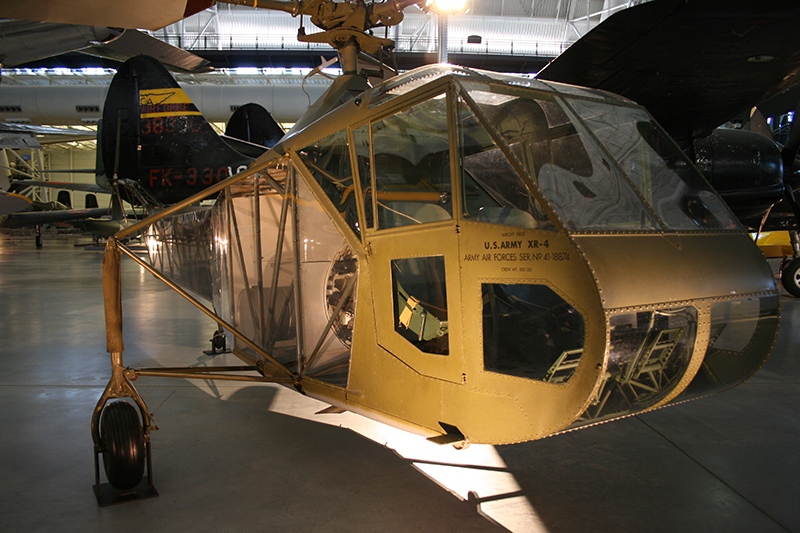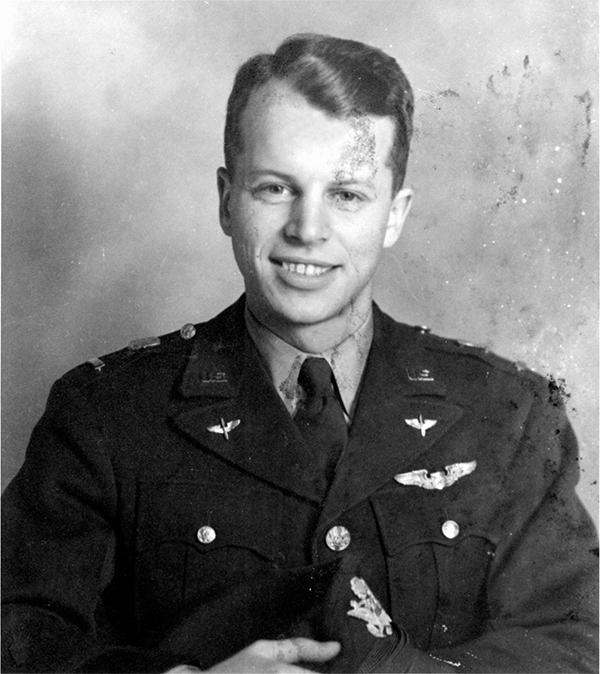
Igor Sikorsky portrait
Posted On: July 10, 2024
On April 21, 1944, while transporting three wounded British soldiers, TSgt. Ed “Murphy” Hladovcak crashed his L-1 Vigilant rescue plane in a rice paddy in Burma, surrounded by jungle, 100 miles from friendly troops, and in Japanese-occupied territory. L-1 Vigilantes and L-5 Sentinels (rescue planes) would have been ideal for this rescue, but in a rice paddy? An L-5 Sentinel located Murphy and the three wounded British soldiers, but the rice paddy and surrounding terrain remained an obstacle. What could be used to rescue multiple patients in such rugged terrain? The answer starts with a man named Igor Sikorsky.
Igor Sikorsky and the VS-300

First flight of the VS-300 on September 14, 1939, in Stratford, Connecticut. Pictured here flying the VS-300 is Igor Sikorsky himself.
Born on May 25, 1889, in Kiev, Imperial Russia (now Ukraine), Igor Ivanovich Sikorsky grew up with parents who encouraged his interest in science. At the age of 14, Igor learned of Wilbur and Orville Wright’s pioneering flight in Kitty Hawk, North Carolina. While working in Paris (known as “the aeronautical center of Europe” at the time) building and testing aircraft, Igor built his first two helicopters, the H-1 in 1909 and the H-2 in 1910. The H-2 had the ability to lift on its own, but it could not sustain the weight of the pilot. In early 1939, Igor began working on the helicopter prototype VS-300. The first tethered flight of the VS-300 was on September 14, 1939 and the first untethered flight on May 13, 1940. On May 6, 1941, the VS-300 reached a record endurance of one hour, thirty-two minutes, and twenty-six seconds. In December 1940, the U.S. Army Air Force awarded a $50,000 contract to Igor and his team to build the VS-316, renamed the XR-4, which made its first flight on January 14, 1942. In 1943, the R-4 became the world’s first mass-produced practical helicopter. Delays in production design caused the U.S. Army Air Force and U.S. Coast Guard to use the R-4 for rescue missions, although it had been originally intended for training purposes.

The XR-4 on display at the Smithsonian’s National Air and Space Museum.
In 1943, a group of men consisting of 2nd Lt. Carter Harman, 1st Lt. John Beeson, 1st Lt. Burt C. Powell, 1st Lt. Frank M. Turney, and Capt. Jack Beighle, and six other members including Crew Chief Jim Phelan went to the Sikorsky factory in Connecticut to learn how to fly the helicopter, becoming the first class of U.S. Army line helicopter pilots. With training complete, the group of newly licensed helicopter pilots made their way back to the China-Burma-India Theater (CBI) to be with the 1st Air Commando Group.
The 1st Air Commando Group answered to Lt. Col. Philip “Flip” Cochran who answered to President Franklin Roosevelt. In February 1944, the Air Commandos requested three helicopters (now called YR-4Bs) to add to their armory. By April 1944, the only qualified helicopter pilot left was 2nd Lt. Carter Harman. One pilot had crashed, passing away, while another was injured from ground fire. It was during this time that TSgt. Murphy and the four wounded British soldiers crashed in a rice paddy desperately waiting to be rescued. Harman was the only one available for the job.
“Send the Eggbeater In”: The YR-4B Proves Its Worth
Five-hundred miles away somewhere in India, Harman observed his newly assembled YR-4B when a message came through to the base in Burma, “Send the eggbeater in.” With orders from Cochran, Harman took his helicopter to Taro. He carried extra cans of fuel in the co-pilot seat as no one in India or Burma possessed the qualifications to be a co-pilot.
With only a 100-mile range in the YR-4B, the journey to Taro took a few days. Meanwhile, Murphy and the three British soldiers climbed and crawled through the jungle trying to hide from Japanese troops, relying on the message dropped from an L-5 Sentinel stating: “MOVE UP MOUNTAIN. JAPANESE NEARBY.” After a few days of travel (taking time to stop, refuel, and rest), Harman arrived at Taro and learned why he had been called upon. Harman then continued to the base for the Air Commandos: Aberdeen . On April 25, 1944, he landed at Aberdeen and prepared to make history.
A sandbar on a nearby river had been located close to where Murphy and the wounded soldiers were. The group could not make it to the riverbank on their own, even though British commandos had secured an area of the bank. However, Harman could reach the four men with the helicopter and take them to the sandbar where they would be transported to safety…but he would have to make four trips. From Aberdeen, Harman, led by a L-5 Sentinel, took off to find the men trapped in the jungle of Burma.

Captain Carter Harman
Harman recalls the moment he located the men, “Hladovcak went crazy when he saw my ‘eggbeater’ arriving…He had, of course, never seen a helicopter before. I was pushing the YR-4B to the limit when I set down in the clearing in a swirl of flying dust and pieces of greenery. Murphy loaded the most seriously injured British soldier aboard. The YR-4B strained, vibrated, and took off. I was able to make it to the sandbar where a liaison plane flew that soldier to safety.” Three men still waited. After picking up the second injured soldier and reaching the riverbank, the engine of the YR-4B seized and overheated. They would have to stay overnight, and harsh weather was expected the next day. The following morning, Harman set out to finish his mission and the engine started! Harman went back to work, picking up the third British soldier and leaving Murphy behind to be rescued next.
As Harman approached Murphy, a group of soldiers wielding rifles came out of the trees approximately 1,000 feet from Murphy’s position! Harman thought, “It’s too late…After all this work, it’s too late…” However, he made it. Murphy climbed aboard just as the engine seized again; sinking back into the jungle. Determined, Harman brought the helicopter back to power and off they went–the first combat rescue mission completed by helicopter. After returning to Aberdeen, they learned that the soldiers seen at take-off were Chindit troops there to help Murphy.
Helicopters have truly made their mark on our lives. The helicopter has been essential for complicated rescue missions in all types of difficult terrain. Pictures of these unique flying machines rescuing injured troops from combat zones covered magazines and newspapers during the Vietnam War, but they proved repeatedly throughout the end of World War II and onward to be an effective instrument in combat and civilian life.
Resources:
- Colucci, Frank, and John Bulakowski. Igor Sikorsky Solves “The Helicopter Problem,” Igor I. Sikorsky Historical Archives, Inc. , Oct. 2019, sikorskyarchives.com/igor-sikorsky-solves-the-helicopter-problem/.
- Dorr, Robert F. “Helicopters in World War II.” Warfare History Network, 6 Dec. 2023, warfarehistorynetwork.com/article/helicopters-in-world-war-ii/.
- History.com Editors. “First Combat Helicopter.” History.Com, A&E Television Networks, 30 May 2012, www.history.com/topics/inventions/first-combat-helicopter-video.
- Sikorsky, Igor. “VS-300: The First Practical Helicopter.” Igor I Sikorsky Historical Archives, Igor I. Sikorsky Historical Archives, Inc. , Jan. 1941, sikorskyarchives.com/vs-300-the-first-practical-helicopter/.
- Smithsonian Institution. “Sikorsky XR-4 Helicopter.” Smithsonian Institution, 23 May 2012, www.si.edu/newsdesk/snapshot/sikorsky-xr-4-helicopter.
- “The Life of Igor Sikorsky.” Igor I Sikorsky Historical Archives, Sikorsky Archives , 20 Apr. 2024, sikorskyarchives.com/home/igor-sikorsky/.
Tags: WWII




IS THAT THE SAME BEESON That was featured in an exhibit at the Boise Airport ?
Hi John,
You may be thinking of Duane Beeson from Boise, ID. You can read more about him in this article: Profiles in Courage: Duane Beeson “The Boise Bee”
Excellent!